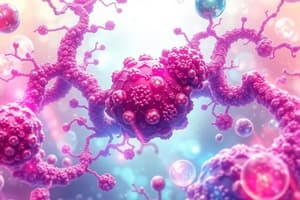Podcast
Questions and Answers
What are the main areas of biochemistry?
What are the main areas of biochemistry?
- Structure and function of biological macromolecules, metabolism and genetics (correct)
- Nutrition, metabolism and genetics
- Structure and function of biological macromolecules, nutrition and metabolism
- Structure and function of biological macromolecules, metabolism and genetics, nutrition, and environmental applications
What is the primary role of biochemistry in the field of medicine?
What is the primary role of biochemistry in the field of medicine?
- Developing new vaccines
- Analyzing blood samples for various components like glucose and cholesterol
- Understanding the mechanism of drug action
- All of the above (correct)
Which of the following is NOT a principle defining a living organism?
Which of the following is NOT a principle defining a living organism?
- Cells have the capacity for precise self-replication and self-assembly
- Living organisms exist in a dynamic steady state
- Cells are the fundamental unit of life
- Living organisms are always in equilibrium with their surroundings (correct)
How do cells use a relatively small set of carbon-based metabolites?
How do cells use a relatively small set of carbon-based metabolites?
What is the primary role of metabolism in living organisms?
What is the primary role of metabolism in living organisms?
Which of the following is NOT a characteristic of a living organism?
Which of the following is NOT a characteristic of a living organism?
How does biochemistry contribute to environmental applications?
How does biochemistry contribute to environmental applications?
What is the role of molecular genetics in biochemistry?
What is the role of molecular genetics in biochemistry?
Which of the following elements are considered 'primary bioelements'?
Which of the following elements are considered 'primary bioelements'?
What is the primary function of 'secondary bioelements' in the body?
What is the primary function of 'secondary bioelements' in the body?
Which of the following is NOT a characteristic of a covalent bond?
Which of the following is NOT a characteristic of a covalent bond?
Which type of chemical bond is responsible for the association of atoms into molecules?
Which type of chemical bond is responsible for the association of atoms into molecules?
Which of the following statements is TRUE about 'oligoelements'?
Which of the following statements is TRUE about 'oligoelements'?
What is the primary difference between atoms and molecules?
What is the primary difference between atoms and molecules?
Which of the following accurately describes the concept of 'electronegativity'?
Which of the following accurately describes the concept of 'electronegativity'?
Why are covalent bonds considered strong bonds?
Why are covalent bonds considered strong bonds?
What is the role of 'bioelements' in living organisms?
What is the role of 'bioelements' in living organisms?
Which of the following levels of organization is characterized by the interaction of different populations within a specific environment?
Which of the following levels of organization is characterized by the interaction of different populations within a specific environment?
Flashcards
Biochemistry
Biochemistry
The molecular study of the structures, mechanisms, and processes of living organisms.
Metabolism
Metabolism
The sum of all chemical reactions that occur in an organism, involving energy transformation.
Cell
Cell
The fundamental unit of life that performs all essential biological processes.
Self-replication
Self-replication
Signup and view all the flashcards
Energy transformation
Energy transformation
Signup and view all the flashcards
Dynamic steady state
Dynamic steady state
Signup and view all the flashcards
Evolution
Evolution
Signup and view all the flashcards
Biomacromolecules
Biomacromolecules
Signup and view all the flashcards
Bioelements
Bioelements
Signup and view all the flashcards
Primary Bioelements
Primary Bioelements
Signup and view all the flashcards
Covalent Bond
Covalent Bond
Signup and view all the flashcards
Molecule
Molecule
Signup and view all the flashcards
Levels of Organization
Levels of Organization
Signup and view all the flashcards
Electronegativity
Electronegativity
Signup and view all the flashcards
Ionic Bond
Ionic Bond
Signup and view all the flashcards
Secondary Bioelements
Secondary Bioelements
Signup and view all the flashcards
Oligoelements
Oligoelements
Signup and view all the flashcards
Molecular Level
Molecular Level
Signup and view all the flashcards
Study Notes
Biochemistry Introduction
- Biochemistry is a molecular description of the structures, mechanisms, and chemical processes of living things.
- It describes the shared structures, mechanisms, and chemical processes in all organisms, providing principles underlying life in diverse forms.
- Biochemists use physical and chemical principles to explain biology at the molecular level.
Impact of Biochemistry
- Medicine: Blood tests (e.g., glucose, cholesterol) and drug development rely on biochemistry.
- Agriculture: Biochemistry explains how fertilizers and pesticides affect crops at the cellular level.
- Industrial applications: Biochemistry impacts food technology and biotechnology
- Environmental applications: Biochemistry helps study how pollutants behave in the body.
Principle Areas of Biochemistry
- Structure and function of biological macromolecules: Organisms maintain internal environments over decades by consuming food, water, and absorbing oxygen.
- Metabolism: Anabolic and catabolic processes provide energy for organism functions and waste removal.
- Molecular Genetics: Describes how life replicates and how protein synthesis is regulated.
Features Defining a Living Organism
- Cells: Fundamental units, create polymeric machines and structures.
- Dynamic steady state: Organisms exist in a dynamic state, not equilibrium, with their environment.
- Self-replication and self-assembly: Cells use genetic information from the genome to replicate and assemble.
- Gradual evolution: Living organisms change over time through gradual evolution.
- Highly organized: Living things have complex organization at various levels, from atoms to cells and beyond.
- Energy extraction: Organisms take in energy from the environment to function.
Atomic Level
- Bioelements: Atoms in the periodic table that are essential to organisms.
- Primary Bioelements: C (Carbon), H (Hydrogen), O (Oxygen), N (Nitrogen) - make up over 99% of the mass of cells.
- Secondary Bioelements: P (Phosphorus), S (Sulfur), Na (Sodium), K (Potassium), Mg (Magnesium), Ca (Calcium), and Cl (Chlorine) – make up about 1% of the mass of cells.
- Oligioelements: Mn, Fe, Co, Cu, Zn, I, F, Mo, Si, B and others –essential to life and specific protein functions, but only in small amounts.
- Electronegativity: Tendency of an atom to attract electrons. Higher electronegativity values increase the likelihood of bonding of an atom.
- Atoms: Protons (positive charge), neutrons (no charge), electrons (negative charge).
- Chemical bonds: Metallic, ionic, covalent (polar and non-polar) - how atoms interact and form molecules.
Molecular Level
- Molecules: Groups of atoms bonded together, representing the smallest units of chemical compounds.
- Chemical bonding: Interactions forming molecules.
- Types of Chemical Bonds: Metallic, ionic, covalent
- Polar Covalent Bond: Unequal sharing of electrons between atoms forming the bond, creating partial positive and partial negative charges on atoms, resulting in polarity.
- Inorganic Biomolecules: Water forms 70% of body weight, Salts are dissolved/solid phase in tissues and essential for osmotic equilibrium; Gases participate in breathing and photosynthesis and are involved in physiological processes.
- Organic Biomolecules: Consist of carbon compounds and only present in living organisms.
- Macromolecules: Large molecules made up of monomers (smaller units).
- Anabolism and Catabolism: The parts of metabolism which are the building-up and breaking-down of molecules.
- Metabolome: All small molecules present in a cell under specific conditions.
Levels of Organization of Living Things (summary)
- Atomic -> Molecular -> Cells -> Tissues -> Organs -> Organism -> Population -> Ecosystem -> Biosphere.
Steady State
- Steady state: A state of dynamic equilibrium in which matter flows and the overall concentration of components remains constant.
- The rates of synthesis and breakdown of molecules must balance.
- It requires a constant input of energy to maintain this dynamic equilibrium since the system is not at equilibrium.
Homeostasis
- Maintaining a steady state through regulatory mechanisms to compensate for external changes.
- Failure of homeostasis can lead to diseases.
Metabolism
- Metabolism is the set of enzyme-catalyzed transformations of organic molecules in living cells.
- It includes pathways for anabolism and catabolism (the sum of building-up and breaking-down of molecules).
Studying That Suits You
Use AI to generate personalized quizzes and flashcards to suit your learning preferences.




